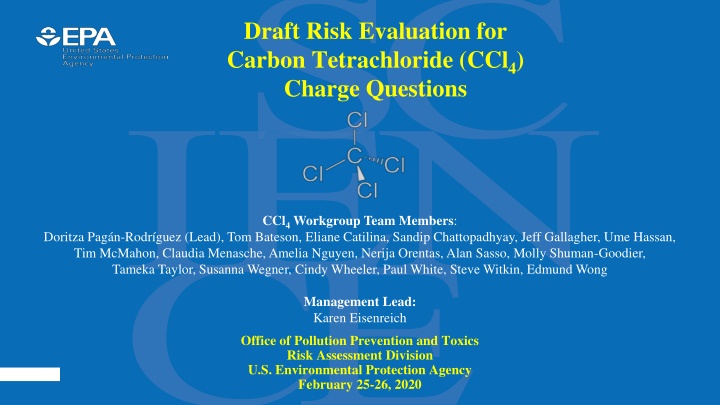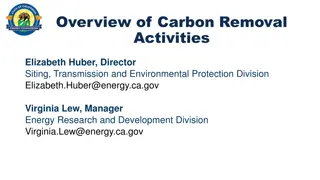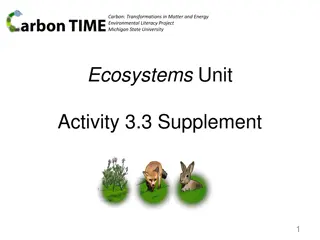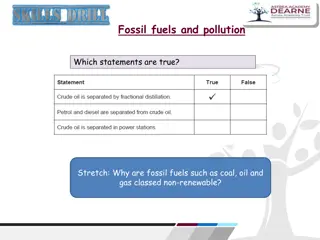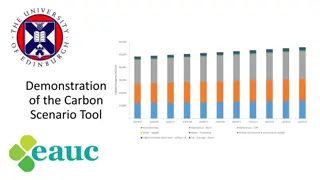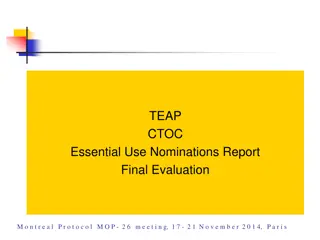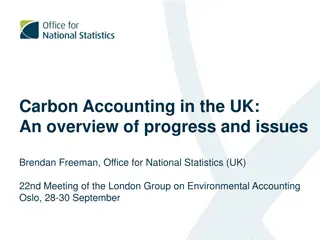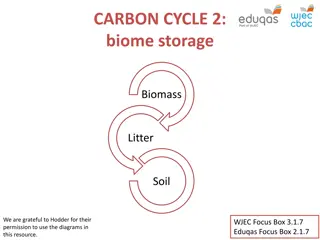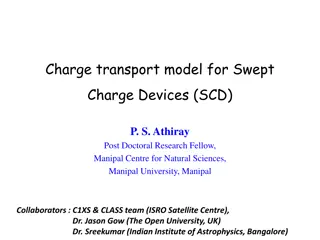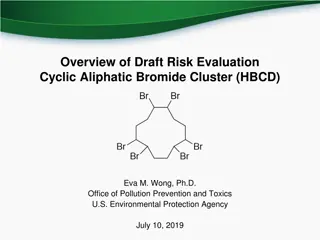Draft Risk Evaluation for Carbon Tetrachloride - Charge Questions for CCl4 Workgroup
Assessment of environmental fate, exposure, hazard, and risk associated with carbon tetrachloride. Evaluation of occupational exposure risks for workers handling the chemical.
Download Presentation

Please find below an Image/Link to download the presentation.
The content on the website is provided AS IS for your information and personal use only. It may not be sold, licensed, or shared on other websites without obtaining consent from the author.If you encounter any issues during the download, it is possible that the publisher has removed the file from their server.
You are allowed to download the files provided on this website for personal or commercial use, subject to the condition that they are used lawfully. All files are the property of their respective owners.
The content on the website is provided AS IS for your information and personal use only. It may not be sold, licensed, or shared on other websites without obtaining consent from the author.
E N D
Presentation Transcript
Draft Risk Evaluation for Carbon Tetrachloride (CCl4) Charge Questions CCl4 Workgroup Team Members: Doritza Pag n-Rodr guez (Lead), Tom Bateson, Eliane Catilina, Sandip Chattopadhyay, Jeff Gallagher, Ume Hassan, Tim McMahon, Claudia Menasche, Amelia Nguyen, Nerija Orentas, Alan Sasso, Molly Shuman-Goodier, Tameka Taylor, Susanna Wegner, Cindy Wheeler, Paul White, Steve Witkin, Edmund Wong Management Lead: Karen Eisenreich Office of Pollution Prevention and Toxics Risk Assessment Division U.S. Environmental Protection Agency February 25-26, 2020
Sections 2.1 and 2.2 Environmental Fate and Exposure Question 1. The environmental fate of carbon tetrachloride is characterized by partitioning to the atmosphere, surface water and groundwater. Carbon tetrachloride in surface water is expected to volatilize and diffuse upwardly in the troposphere, with a half- life greater than 330 years. Ultimate diffusion to the stratosphere leads to photodegradation. Carbon tetrachloride has a low bioaccumulation potential and when in groundwater is expected to anaerobically biodegrade. EPA did not further analyze the environmental fate of carbon tetrachloride as indicated by the conceptual models in the problem formulation. 1.1 Please comment on the data, approaches and/or methods used to characterize exposure to aquatic receptors. 3
Sections 3.1 and 4.1 Environmental Hazard and Risk Characterization Question 2. An analysis of potential risk to aquatic species indicates that expected environmental concentrations are below hazard thresholds for aquatic species based on using environmental hazard data, Probabilistic Dilution Model (PDM) within E- FAST, Discharge Monitoring Reports (DMR) data, fate information, and physical/chemical properties. In addition, a qualitative consideration of physical- chemical properties and the conditions of use in this assessment indicate that risks to sediment-dwelling invertebrate species are not expected. 2.1 Please comment on whether the information presented supports the hazard and risk findings in the draft environmental hazard section (Section 3.1) and draft risk characterization section (Section 4.1). 4
Section 2.4 Occupational Exposure and Releases Question 3. Workers and occupational non-users may be exposed to carbon tetrachloride when performing activities associated with conditions of use including, but not limited to: Connecting/disconnecting transfer lines used to unload carbon tetrachloride containers into storage or reaction vessels Cleaning and maintaining equipment Sampling chemical formulations containing carbon tetrachloride for quality control Repackaging products containing carbon tetrachloride Handling, transporting and disposing wastes containing carbon tetrachloride Performing other work activities in or near areas where carbon tetrachloride is used. 3.1 Please comment on the characterization of occupational exposure for workers and occupational non-users. Is the occupational exposure characterization supported by the information presented in Section 2.4 of the Draft Risk Evaluation? What other additional information, or approaches if any, should be considered? 5
Section 2.4 Occupational Exposure and Releases Question 3. EPA distinguishes between workers (users) and occupational non-users (ONUs) to acknowledge that different tasks and activities are associated with different levels of exposures and thus risk in the same workplace. EPA assumes that area air monitoring is an appropriate surrogate for ONUs exposure. In the absence of ambient air monitoring data, EPA assumes that the central tendency of personal breathing zone (PBZ) monitoring data is a good surrogate for ONU exposures because the agency rarely has PBZ monitoring data for ONUs. 3.2 Please comment on the scientific validity and transparency of EPA s approach and the assumptions EPA used to characterize exposure for ONUs. Please also comment on the uncertainties related to the assumptions used to characterize exposures for ONUs. 6
Section 2.4 Occupational Exposure and Releases Question 3. Workplace inhalation exposure concentrations to carbon tetrachloride were estimated for adults using a combination of monitoring data and modeled exposure air concentrations. For dermal exposures, EPA modeled exposures for workers using parameters such as exposed skin surface areas, body weight, and glove protection factors, if applicable. EPA used literature sources for estimating many of these occupational exposure parameters and generic assumptions when data were not available. 3.3 Please comment on the approaches and assumptions used and provide any specific suggestions or recommendations for alternative approaches, models or information that should be considered by the Agency for improving the workplace exposure assessment. More specifically, if other sources of monitoring data are available to estimate air concentrations for worker exposures, please provide specific citations. 7
Section 2.4 Occupational Exposure and Releases Question 3. 3.4 Please comment on assumptions used in the absence of specific exposure information (e.g., dermal surface area assumptions: high-end values, which represents two full hands in contact with a liquid: 890 cm2 (mean for females),1070 cm2 (mean for males); central tendency values, which is half of two full hands (equivalent to one full hand) in contact with a liquid and represents only the palm-side of both hands exposed to a liquid: 445 cm2 (females), 535 cm2 (males)). 3.5 Please comment on EPA s approach to characterizing the strengths, limitations and overall confidence for each occupational exposure scenarios presented in Section 2.4.1. Please comment on the appropriateness of these confidence ratings for each scenario. Please also comment on EPA s approach to characterizing the uncertainties summarized in Section 4.4.1. 8
Section 3.2 Human Health Effects Question 4. EPA evaluated human health hazards as follows: Reviewed reasonably available human health hazard data and determined whether specific subgroups may have greater susceptibility to carbon tetrachloride hazard(s) than the general population Conducted hazard identification (the qualitative process of identifying non-cancer and cancer endpoints) and dose-response assessment (the quantitative relationship between hazard and exposure) for all identified human health hazard endpoints Derived points of departure (PODs) where appropriate Adjusted the PODs as appropriate to conform to the specific exposure scenarios evaluated (e.g., adjust for duration of exposure) 9
Section 3.2 Human Health Effects Question 4. Considered the route(s) of exposure (inhalation, dermal), available route-to-route extrapolation approaches, and the available approaches to correlate internal and external exposures to integrate the exposure and hazard assessments Evaluated the weight of the scientific evidence based on the available human health hazard data for carbon tetrachloride. 4.1 Please comment on the reasonableness of the evaluation of human health hazards. Are there any additional carbon tetrachloride specific data and/or other information that should be considered? 10
Section 3.2 Human Health Effects Question 4. EPA used a linear low-dose extrapolation for evaluating potential cancer risks from chronic exposures to carbon tetrachloride. 4.2 Please comment on rationale for selection of tumor type for dose response for cancer. 4.3 Please comment on the appropriateness of using a linear low-dose extrapolation versus a non-linear or threshold approach for assessing low exposures based on the cancer mode of action information presented in Section 3.2 and Appendix K. 11
Section 3.2 Human Health Effects Question 4. There are a limited number of quantitative studies on the absorption and systemic toxicity of carbon tetrachloride by the dermal route. Therefore, PODs for dermal exposures are based on (1) use of one unacceptable study and one acceptable study with similar dosing regimens in a weight of evidence approach, (2) estimation of dermal absorption over time of exposure; (3) estimation of evaporation losses for non-occluded exposures and (4) extrapolation of dermal POD from inhalation POD (for chronic exposures). 4.4 Please comment on the appropriateness of the approaches used for generating PODs for dermal exposures, including the process/equation for extrapolating the cancer slope factor (CSF) and POD for chronic dermal exposures (dermal HED). 12
Section 4 Risk Characterization Question 5. EPA calculated human health risks for acute and chronic exposures. For non- cancer effects EPA used a margin of exposure (MOE), which is the ratio of the hazard value to the exposure to calculate human health risks. Using an acute non- cancer POD, EPA evaluated potential acute risks for workers for certain scenarios. A benchmark MOE of 10 was used with the acute POD based on central nervous system (CNS) effects. For chronic occupational risks, EPA used a POD for liver effects as the basis of the chronic non-cancer MOE calculations. A benchmark MOE of 30 was used to interpret chronic risks for workers. An Inhalation unit risk (IUR) for adrenal gland tumors was used to evaluate potential chronic risks to cancer endpoints for worker exposure scenarios. The risk characterization also provides a discussion of the uncertainties surrounding the risk calculations. 13
Section 4 Risk Characterization Question 5. 5.1 Please comment on whether the information presented supports the finding outlined in the draft risk characterization section. If not, please suggest alternative approaches or information that could be used to further develop risk estimates within the context of the requirements stated in EPA s Final Rule, Procedures for Chemical Risk Evaluation Under the Amended Toxic Substances Control Act (82 FR 33726). 5.2 Please comment on the characterization of uncertainties and assumptions including whether EPA has presented a clear explanation of underlying assumptions, and accurate contextualization of uncertainties. Please provide information on additional uncertainties and assumptions that EPA has not adequately presented. 14
Section 4 Risk Characterization Question 5. 5.3 Please comment on the validity of specific confidence summaries presented in section 4.5. 5.4 Please comment on the objectivity of the selection of the data used to support the risk characterization and the sensitivity of the agency's conclusions to analytic assumptions made. 5.5 Please comment on any other aspects of the human health risk characterization that has not been mentioned above. 15
Section 4 Risk Characterization Question 5. The Frank R. Lautenberg Chemical Safety for the 21st Century Act (2016; amended TSCA (TSCA 6(b)(4)(A)) requires that potentially exposed or susceptible subpopulations (PESS) be considered in the risk evaluation process. 5.6 Please comment on whether the risk evaluation has adequately addressed potentially exposed or susceptible subpopulations in Sections 3.2.5.4 and 4.3. 5.7 Please comment on whether the risk evaluation document has adequately described the uncertainties and data limitations associated with the methodologies used to assess the human health risks with respect to potentially exposed or susceptible subpopulations. Please comment on whether this information is presented in a clear and transparent manner. 16
Section 4 Risk Characterization Question 5. EPA characterization of human health risk from inhalation exposure to workers includes estimates of risk for respirator use. These estimates are calculated by multiplying the high end and central tendency MOE or extra cancer risk estimates without respirator use by the respirator assigned protection factors (APFs) of 10, 25 and 50 (air-supplied respirators). EPA did not assume occupational non users (ONUs) or consumers used personal protective equipment in the risk estimation process. 5.8 Please comment on whether EPA has adequately, clearly, and appropriately presented the reasoning, approach, assumptions, and uncertainties for characterizing risk to workers using PPE. 17
Content and Organization Question 6. EPA s Final Rule, Procedures for Chemical Risk Evaluation Under the Amended Toxic Substances Control Act (82 FR 33726) stipulates the process by which EPA is to complete risk evaluations under the Frank R. Lautenberg Chemical Safety for the 21st Century Act. To that end, EPA has completed a draft risk evaluation for carbon tetrachloride. As part of this risk evaluation for carbon tetrachloride, EPA evaluated potential environmental and occupational exposures. The evaluation considered reasonably available information, including manufacture, use, and release information, and physical-chemical characteristics. It is important that the information presented in the risk evaluation and accompanying documents is clear and concise and describes the process in a scientifically credible manner. 18
Content and Organization Question 6. To increase the quality and credibility of scientific information disseminated by EPA, EPA uses the peer review process specifically as a tool for determining fitness of scientific information for the intended purpose. The questions below are intended to guide the peer reviewers toward determining if EPA collected, used and disseminated information that is fit for purpose based on utility (the data's utility for its intended users and for its intended purpose), integrity (the data's security), and objectivity (whether the disseminated information is accurate, reliable, and unbiased as a matter of presentation and substance). The peer reviewers critical focus should pertain to recommendations of the technical information s usefulness for intended users and the public. 19
Content and Organization Question 6. 6.1 Please provide suggestions for improving the clarity of the information presented in the draft risk evaluation. 6.2 Is the draft risk evaluation narrative presented in an objective and balanced manner and supportive of the risk characterization? If not, please provide some specific recommendations to improve the draft risk evaluation in this area. 6.3 Is the quality of the data used in the risk characterization appropriate for the purposes of the evaluation? If not, please provide specific examples and recommendations that may include additional data that EPA could consider in their assessment. 20
Content and Organization Question 6. 6.4 Are the uncertainties and assumptions underlying the risk assessment transparently documented? If not, which uncertainties and assumptions could benefit from additional contextualization and/or clarification? 6.5 What additional analyses might provide useful insight into the sensitivity of the risk characterization conclusions, including but not limited to the assumptions mentioned in Sections 2, 3, 4, and 5 of the draft risk evaluation? 21
